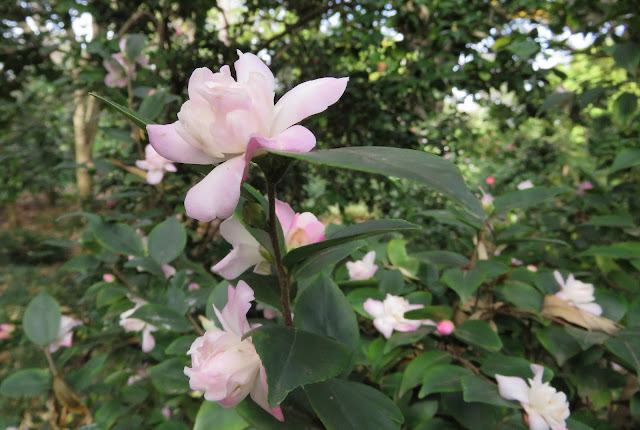Sophie's choice: camellia or seaweed?
Volunteer and camellia enthusiast (and expert) at Royal Botanic Gardens Victoria, Jenny Happell, sent me a message after my post on the algae-backed turtle from Mittagong. After expressing some concern for the turtle, Jenny told me there was a camellia cultivar named after Sophie Ducker, the phycologist (algal expert) who described and named that alga in 1958.
Not only that, but the cultivar can be found in our Melbourne Gardens. So I stepped out of my office immediately, in early July, and headed over to the Camellia Bed to take these pictures.
As you can see, Camellia japonica 'Sophie Ducker' has small, unassuming, pink and white flowers. Which, as Jenny hinted, may be at odds with my previous colleague and sometime friend Sophie's personality.
Jenny told me of a few other specimens in Melbourne Gardens, all struggling for attention due to competing vegetation. That, I replied, is more apt for Sophie.
My lasting recollection of Sophie is interrupting my Honours seminar to tell me that waterfowl would most likely be responsible for the distribution of the algal species I had discovered (only partly true) and that I had missed some collections she had made a few decades earlier (not true, I just didn't mention them).
Sophie also, quite reasonably in this instance, took me to task for the many errors in the list of references at the end of the resulting thesis. She was sometimes right.
But there was much more to Sophie than annoying the occasional honours student. Her good friend Sara Maroske has written about Sophie's life, some of it reproduced on the Australian National Botanic Gardens Biography site. I've borrowed from that here, and you can find more information and (error-free) references at the Australian Encyclopedia of Australian Science and in the journal Phycologia.
Born in Berlin in 1909, Sophie lived to be 95. The second world war interrupted her university education where she was studying to become a botanist but in 1944 she became a research assistant at the University of Melbourne. She worked there as an employee (30 years) and then honorary associate up to and beyond my Honours year in 1981.
Sophie described her career as transitioning from mycologist (fungal expert) to phycologist (algal expert) through to botanical historian. I caught her at the intersection of the latter two, captured beautifully in her 1988 biography of Irish botanist and phycologist William Harvey, The Contented Botanist.
 |
| Camellia japonica 'Sophie Ducker' to the right |
In recent years I have reconnected, belatedly and posthumously, with Sophie, through becoming Patron of the Australian Gardens History Society. She would be amused by this - at first scoffing, then saying what an important role it was and giving me advice on how to do it better. Sophie was an active member of the society and, as Sara put it 'As well as writing about historic gardens, Sophie’s interest in this subject found expression in her own exquisite garden in which each plant seemed to have its own story...'
Also, as again well expressed by Sara, Sophie had to make her way in a profession dominated by men: '...her own career was an inspiration to other women and [she] left a substantial collection of her own records at the University of Melbourne Archives... Her willingness to acknowledge issues of gender, nationality and family in shaping a career set her apart from many of her generation who wanted to believe in academia as a meritocracy. In so doing, however, she always remained positive about what has been, and what can be achieved by women in their chosen fields of endeavour.'
The camellia, though, is easier for us to enjoy. It was created by famed camellia grower and breeder Bob Withers, from Donvale. It first flowered in 1994, when Sophie was 85 years old, and was named in her honour in 1998.
Take a look at the pretty specimen in the Camellia Bed, or take more time to find the others among the vast collections of Melbourne Gardens. Sophie would recommend the latter I'm sure. I have no idea what Sophie thought about this selection but I know she will have been chuffed to have her name on a sign in Royal Botanic Gardens Victoria.




Comments